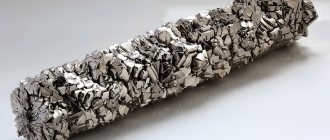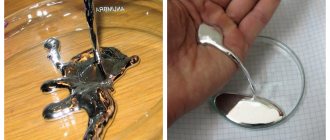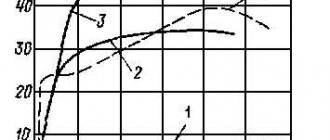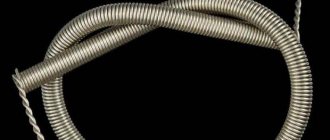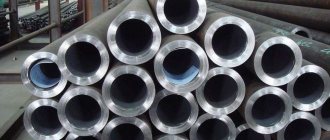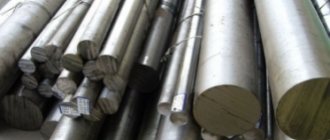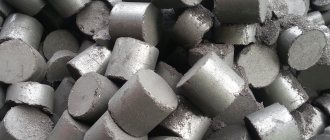04/30/2021 Author: VT-METALL
Issues discussed in the material:
- How was aluminum discovered and what are its main properties?
- Basic physical properties of aluminum
- Basic chemical properties of aluminum
- How to use the basic properties of aluminum
- How to use the basic properties of aluminum in construction
The basic properties of aluminum make this material truly versatile and valuable. It is used in all types of industrial production, in agriculture, in everyday life, in commerce. It has a huge number of advantages over steel and other types of metal.
The most popular applications of aluminum are the manufacture of metal structures and metalworking. Read on to learn about the properties of the metal and where exactly they found their application.
How was aluminum discovered and what are its main properties?
Aluminum is a paramagnetic metal, quite light, with a silvery color. It lends itself well to machining and casting, and is easy to mold. In the earth's crust, this element is the third most abundant, ahead only of oxygen and silicon. Our subsoil contains as much as 8% of this metal, which is significantly more than gold, the amount of which is no more than five millionths of a percent.
Aluminum is actively used in most areas of production. Its alloys are used for the manufacture of household appliances, transport, mechanical engineering and electrical engineering. Capital construction also cannot do without it.
VT-metall offers services:
It is extremely common in the earth's crust, being the first of the metals and the third chemical element (the first place is for oxygen, the second is for silicon). The share of aluminum in our subsoil is 8.8%. The metal is part of a large number of rocks and minerals, the main of which is aluminosilicate.
In the form of compounds, aluminum is found in basalts, feldspars, granites, clay, etc. However, it is mainly obtained from bauxites, which are quite rarely found in the form of deposits. In Russia, such deposits are found only in the Urals and Siberia. On an industrial scale, aluminum can also be mined from nephelines and alunites.
We recommend articles on metalworking
- Steel grades: classification and interpretation
- Aluminum grades and areas of their application
- Defects in metal products: causes and search methods
Animal and plant tissues contain aluminum as a trace element. Some organisms, for example, mollusks and mosses, are its concentrators, accumulating it in their organs.
Humanity has been familiar with an aluminum compound called potassium alum for a long time. It was used in the process of tanning leather, as a means that, when swelling, binds the various components of the mixture. In the second half of the 18th century. scientists discovered aluminum oxide. But the substance was obtained in its pure form much later.
This was first achieved by C.K. Oersted, who isolated aluminum from chloride. While conducting the experiment, he treated potassium salts with amalgam, as a result of which a gray powder emerged, recognized by all as pure aluminum.
Subsequently, by studying the metal, scientists determined its chemical properties, manifested in its high ability to recover and activity. That is why they did not work with aluminum for a long time.
But already in 1854, the French scientist Deville, using electrolysis of the melt, managed to obtain metal in ingots. This method is still used today. Aluminum began to be produced on an industrial scale at the beginning of the 20th century, when enterprises were able to gain access to large amounts of electricity.
Today, aluminum is one of the most used metals in the production of household appliances and construction.
Production of aluminum.
The documented discovery of aluminum occurred in 1825. This metal was first obtained by the Danish physicist Hans Christian Oersted, when he isolated it by the action of potassium amalgam on anhydrous aluminum chloride (obtained by passing chlorine through a hot mixture of aluminum oxide and coal). Having distilled off the mercury, Oersted obtained aluminum, although it was contaminated with impurities. In 1827, the German chemist Friedrich Wöhler obtained aluminum in powder form by reducing hexafluoroaluminate with potassium:
Na3AlF6 + 3K ® Al + 3NaF + 3KF. Later he managed to obtain aluminum in the form of shiny metal balls. In 1854, the French chemist Henri Etienne Saint-Clair Deville developed the first industrial method for producing aluminum - by reducing the melt of tetrachloroaluminate with sodium: NaAlCl4 + 3Na ® Al + 4NaCl. However, aluminum continued to be an extremely rare and expensive metal; it was not much cheaper than gold and 1500 times more expensive than iron (now only three times). A rattle was made from gold, aluminum and precious stones in the 1850s for the son of French Emperor Napoleon III. When a large ingot of aluminum produced by a new method was exhibited at the World Exhibition in Paris in 1855, it was looked upon as if it were a jewel. The upper part (in the form of a pyramid) of the Washington Monument in the US capital was made from precious aluminum. At that time, aluminum was not much cheaper than silver: in the USA, for example, in 1856 it was sold at a price of 12 dollars per pound (454 g), and silver for 15 dollars. In the 1st volume of the famous Brockhaus Encyclopedic Dictionary published in 1890, Efron said that “aluminum is still used primarily for the manufacture of... luxury goods.” By that time, only 2.5 tons of metal were mined annually throughout the world. Only towards the end of the 19th century, when an electrolytic method for producing aluminum was developed, its annual production began to amount to thousands of tons, and in the 20th century. – million tons. This transformed aluminum from a semi-precious metal to a widely available metal.
The modern method of producing aluminum was discovered in 1886 by a young American researcher, Charles Martin Hall. He became interested in chemistry as a child. Having found his father's old chemistry textbook, he began to diligently study it and carry out experiments, once even receiving a scolding from his mother for damaging the dinner tablecloth. And 10 years later he made an outstanding discovery that made him famous throughout the world.
As a student at age 16, Hall heard from his teacher, F. F. Jewett, that if someone could develop a cheap way to produce aluminum, that person would not only do a great service to humanity, but also make a huge fortune. Jewett knew what he was saying: he had previously trained in Germany, worked with Wöhler, and discussed with him the problems of producing aluminum. Jewett also brought a sample of the rare metal with him to America, which he showed to his students. Suddenly Hall declared publicly: “I will get this metal!”
Six years of hard work continued. Hall tried to obtain aluminum using different methods, but without success. Finally, he tried to extract this metal by electrolysis. At that time there were no power plants; current had to be generated using large homemade batteries from coal, zinc, nitric and sulfuric acids. Hall worked in a barn where he set up a small laboratory. He was helped by his sister Julia, who was very interested in her brother’s experiments. She preserved all his letters and work journals, which make it possible to literally trace the history of the discovery day by day. Here is an excerpt from her memoirs:
“Charles was always in a good mood, and even on the worst days he was able to laugh at the fate of unlucky inventors. In times of failure, he found solace at our old piano. In his home laboratory he worked for long hours without a break; and when he could leave the set up for a while, he would rush across our long house to play a little... I knew that, playing with such charm and feeling, he was constantly thinking about his work. And music helped him with this.”
The most difficult thing was to select an electrolyte and protect the aluminum from oxidation. After six months of exhausting labor, several small silver balls finally appeared in the crucible. Hall immediately ran to his former teacher to tell him about his success. “Professor, I got it!” he exclaimed, holding out his hand: in his palm lay a dozen small aluminum balls. This happened on February 23, 1886. And exactly two months later, on April 23 of the same year, the Frenchman Paul Héroux took out a patent for a similar invention, which he made independently and almost simultaneously (two other coincidences are also striking: both Hall and Héroux were born in 1863 and died in 1914).
Now the first balls of aluminum produced by Hall are kept at the American Aluminum Company in Pittsburgh as a national relic, and at his college there is a monument to Hall, cast from aluminum. Jewett subsequently wrote: “My most important discovery was the discovery of man. It was Charles M. Hall who, at the age of 21, discovered a method of reducing aluminum from ore, and thus made aluminum that wonderful metal which is now widely used throughout the world.” Jewett's prophecy came true: Hall received wide recognition and became an honorary member of many scientific societies. But his personal life was unsuccessful: the bride did not want to come to terms with the fact that her fiancé spends all his time in the laboratory, and broke off the engagement. Hall found solace in his native college, where he worked for the rest of his life. As Charles’s brother wrote, “College was his wife, his children, and everything else—his whole life.” Hall bequeathed the majority of his inheritance to the college - $5 million. Hall died of leukemia at the age of 51.
Hall's method made it possible to produce relatively inexpensive aluminum on a large scale using electricity. If from 1855 to 1890 only 200 tons of aluminum were obtained, then over the next decade, using Hall’s method, 28,000 tons of this metal were already obtained worldwide! By 1930, global annual aluminum production reached 300 thousand tons. Now more than 15 million tons of aluminum are produced annually. In special baths at a temperature of 960–970 ° C, a solution of alumina (technical Al2O3) in molten cryolite Na3AlF6, which is partially mined in the form of a mineral, and partially specially synthesized, is subjected to electrolysis. Liquid aluminum accumulates at the bottom of the bath (cathode), oxygen is released at the carbon anodes, which gradually burn. At low voltage (about 4.5 V), electrolysers consume huge currents - up to 250,000 A! One electrolyzer produces about a ton of aluminum per day. Production requires a lot of electricity: it takes 15,000 kilowatt-hours of electricity to produce 1 ton of metal. This amount of electricity is consumed by a large 150-apartment building for a whole month. Aluminum production is environmentally hazardous, since the atmospheric air is polluted with volatile fluorine compounds.
Basic physical properties of aluminum
The main characteristics of aluminum are high electrical and thermal conductivity, ductility, resistance to cold and corrosion. It can be processed by rolling, forging, stamping, drawing. Aluminum is highly weldable.
Impurities present in the metal in varying quantities significantly worsen the mechanical, technological and physicochemical properties of pure aluminum. The main ones are titanium, silicon, iron, copper and zinc.
According to the degree of purification, aluminum is divided into technical metal and high purity. In practice, the differences between these types lie in their resistance to corrosion in different environments. The cost directly depends on the purity of the aluminum. Technical metal is suitable for the production of rolled products, various alloys, cable and wire products. Pure is used for special purposes.
Aluminum has high electrical conductivity, second only to gold, silver, and copper. However, the combination of this indicator with low density allows it to be used in the production of cable and wire products on a par with copper. The electrical conductivity of a metal can increase during prolonged annealing or deteriorate during cold-working.
By increasing the purity of aluminum, manufacturers increase its thermal conductivity. Impurities of copper, manganese and magnesium can reduce this property. Only copper and silver have higher thermal conductivity. It is thanks to this property that this metal is used for the production of cooling radiators and heat exchangers.
The specific heat of aluminum, as well as its melting point, is quite high. These indicators significantly exceed similar values for most metals. As the purity of the metal increases, its ability to reflect light rays from the surface also increases. Aluminum is highly polishable and anodizes well.
The metal is close in properties to oxygen; its surface in air is quickly covered with a thin and durable film of aluminum oxide. Possessing anti-corrosion properties, it protects the metal from rust formation and prevents further oxidation. Aluminum does not interact with nitric acid (concentrated and diluted) and organic acids, it is resistant to fresh and salt water.
These features of aluminum make it resistant to corrosion, which is what people use. That is why it is especially widely used in construction. Interest in it is also increasing because of its lightness combined with strength and softness. Not every substance has such characteristics.
In addition to the above, aluminum has several more interesting physical properties:
- Malleability and ductility - aluminum has become a material for the manufacture of strong and lightweight thin foil, as well as wire.
- Melting occurs at a temperature of +660 °C.
- Boiling point +2 450 °C.
- Density – 2.7 g/cm³.
- The presence of a volumetric face-centered metal crystal lattice.
- Connection type: metal.
Effect on the body
The effect of aluminum on the human body is a fairly pressing topic, given the widespread use of the chemical element. Very often people wonder if food grade aluminum is harmful? How does metal affect human organs? The most interesting thing is that in fact the person is literally saturated with aluminum. The element is found in various forms throughout almost the entire body system, and can also accumulate in the brain, kidneys, lungs, musculoskeletal system, liver and nervous structures. But the substance performs special functions in the structure or regeneration of epithelial and dense connective tissue.
The biological role of the element in the human body is important, as it has an active effect on the digestive tract:
- promotes the processes of the glands of the endocrine system;
- regulates the activity of digestive enzymes;
- takes part in the formation of protein and phosphate compounds;
- promotes cell restoration;
- during the digestion of nutrients, it increases the effectiveness of digestive juice.
Aluminum can have a positive physiological effect on the living body for those people who suffer from peptic ulcers, gastritis, osteoporosis, or are recovering from fractures.
Contents in products and other sources
The content of aluminum forms in food or auxiliary sources is varied. The most common forms are water and various edible products. There are a lot of toxic aluminum salts in the water, which accumulate in the liquid. The element enters clean water even through purification devices, since aluminum alum is used in filtration structures.
Plant products are richer in the presence of metal than animal products. The largest amount of the element is found in:
- potato;
- avocado;
- bakery products;
- eggplant;
- peas;
- oats;
- beans;
- semolina;
- pasta;
- nutmeg;
- strawberries;
- carrot;
- corn;
- apples;
- kiwi;
- peaches.
The daily norm of aluminum as a microelement has not been fully established by scientists; according to some data, the amount of aluminum in the body should be about 2 g, others argue that the mass of the metal should not exceed 50 mg. It is worth noting that by taking food and water, we receive from 30 to 100 mg of the substance daily, depending on the place and lifestyle, as well as diet, so it is not advisable to use any other drugs.
Aluminum is taken by a person every day, and the body, like a well-functioning mechanical machine, constantly removes excess metal, assimilating about 4 percent. The rest of the substances are eliminated by sweating, defecation, and even by exhaling processed air.
When the functioning of the human body is weakened, part of the element accumulates in the lungs, kidneys and brain, causing various diseases.
In order to maintain an optimal balance of aluminum, it is necessary to reduce its intake by avoiding products that contain dyes and preservatives: baked goods, candies, sausages, snacks, etc. The marking that indicates aluminum under the code E 520-523 will help you detect the presence of aluminum on purchased products. The content of aluminum particles in such products, although small, is still harmful.
In human life, in addition to plant and other food products, there are products that also contain impurities, partially or completely consisting of aluminum. Aluminum containers surround us everywhere: at home - dishes that deteriorate over time if they are cleaned or scratched with the wrong product, losing their protective top layer, they oxidize and release harmful particles. Canned food in cans, which during long-term storage strongly absorb microparticles of metal. The same applies to non-alcoholic or low-alcohol drinks in metal cans and tetrapacks.
Today, dry or aerosol deodorants also expose our body to a certain risk. Aluminum salts, as active components that mask unpleasant odors, clog the sweat glands, resulting in the return of toxins into the bloodstream. Therefore, scientists propose using more environmentally friendly materials based on alum or volcanic salt.
Decorative cosmetics, beloved by all women, in the form of foundations, lipsticks or mascara, require a thoughtful approach and the right choice. The cost of more natural cosmetics is, of course, higher, but this is only a small price to pay for a healthy lifestyle.
You can avoid large amounts of aluminum in your body by consuming magnesium, zinc, calcium or silver ions. But along with neutralizing the excess substance, microelements can completely remove aluminum.
Flaw
A deficiency of aluminum elements is a very rare phenomenon, because the substance is found in many products. But, nevertheless, there are exceptions, which, in turn, can cause:
- impaired motor skills and movement coordination;
- inhibition of the growth of the child’s body;
- weakness in the limbs and throughout the body.
But, given the active use of aluminum in the modern world, we can say with confidence that this microelement is found in abundance in almost all organisms.
Excess
Unfortunately, an excess of the substance occurs very often recently, since the versatility of the metal has allowed it to occupy one of the first places not only in construction, but also in the food industry, as well as in the production of equipment.
An excess of a chemical element can be detected by the following factors:
- disorders of nervous structure processes;
- depressive disorder;
- osteoporosis;
- decreased concentration and memory loss;
- neurological diseases with syndromes of shaking paralysis, speech inhibition, memory loss and logical thought processes;
- anemia;
- renal failure;
- autoimmune diseases;
- interruptions in metabolism;
- development of various neoplasms;
- diseases of the reproductive system in both women and men;
- decreased appetite, bowel disorders or constipation.
There is also a specific disease - pneumoconiosis (aluminosis), which develops as a result of regular inhalation of dust particles or aluminum oxides. This disease mainly affects people working in aircraft manufacturing, large-scale construction or metal production.
Symptoms of an overabundance of the substance during aluminosis can be noticed already in the early stages in the form of shortness of breath, pain in the chest and stomach, cough, general weakness, loss of appetite, nausea, dermatitis.
You can monitor the presence of a chemical element in the body by taking various tests. For the study, hair, urine and blood are taken, as well as a biopsy and X-ray examinations. If the results show an increased concentration of aluminum compounds in the body, then the attending physicians must prescribe specialized drugs based on enterosorbents, bronchodilators, antihistamines and others.
It takes a very long time to remove aluminum from the body, since it is thoroughly absorbed into the blood. In addition to medications, the patient is prescribed health-improving exercises and a certain meal.
How to remove a chemical element entering in small quantities from the body? According to the advice of American scientists, you should regularly drink carrot juice, which washes the substance out of the tissues.
If metal poisoning occurs, you can provide first aid to the victim before doctors arrive. First of all, the patient is taken to fresh air for unlimited access to oxygen. Then the victim is given enterosorbents such as activated carbon, enterol and others. In a medical institution, the patient is already injected intravenously with deferoxamine, which binds metal ions and promotes their excretion. Excess aluminum is removed with auxiliary diuretics, choleretic and antioxidant agents.
Basic chemical properties of aluminum
From a chemical point of view, aluminum is an extremely strong reducing agent, capable of being a highly active substance in its pure form. The main condition is to remove the oxide film.
Aluminum is capable of reacting with:
- alkaline compounds;
- acids;
- gray;
- halogens.
Aluminum does not interact with water under normal conditions. Iodine is the only halogen with which the metal reacts without heating. To interact with others, an increase in temperature is required.
Let's look at a few examples showing the chemical properties of this metal. These are equations illustrating the interaction with:
- alkalis: 2Al + 6H2O + 2NaOH = Na[Al(OH)4] + 3H2;
- acids: AL + HCL = AlCL3 + H2;
- gray: 2AL + 3S = AL2S3;
- halogens: AL + Hal = ALHal3.
The main property of aluminum is its ability to restore other substances from their compounds.
The reactions of its interaction with oxides of other metals clearly demonstrate all the reducing properties of the substance. Aluminum perfectly separates metals from various compounds. An example would be: Cr2O3 + AL = AL2O3 + Cr.
The metallurgical industry actively uses this ability of aluminum. The method of obtaining substances, which is based on this reaction, is called aluminothermy. The chemical industry uses aluminum most often to produce other metals.
Application area
Aluminum plate. It has noise-insulating properties, protects against vibration, fire and moisture. Various building structures, decorative roof elements, edgings, circles, beams, and profiles are made from it. It is an important element in mechanical engineering, where it is used as the basis for load-bearing struts. In the aviation industry, these products are used for lining fuselages and in the structure of airframes themselves. This product is also important for obtaining fuel and hydraulic equipment.
Aluminum sheet. Due to its variety of shapes, it is used in the decoration of buildings. It is also in demand in the manufacture of frames, filters and ventilation ducts. It is used to make tanks, food cans, containers, countertops, and sinks. The material does not react with food, does not emit hazardous substances and does not affect taste.
Aluminum pipe. Indispensable when constructing pipelines for oil production, as it does not react with substances. Due to their good throughput, such products are the best option when developing sewerage and water supply systems. Water moves quickly through them, without the formation of traffic jams.
Aluminum wire. It is used for welding work, during installation of power lines, in electrical engineering, and in lightning protection systems. It is a raw material in the production of cable and conductor products. It is also used to produce equipment for trade, elements of facades, design details for houses, and dishes.
Aluminum corners. They are in demand in the manufacture of cabinet and upholstered furniture, advertising equipment, cabinets, and shelving. This is a favorite element of designers, as it not only protects furniture structures, but also emphasizes their originality. Small and narrow varieties are also in demand when installing window frames. Large products - when installing large structures.
Aluminum rod. It is not magnetized, is not afraid of temperature changes, has good electrical conductivity and is light weight. Used in machine tool and mechanical engineering. Used as blanks for the production of fasteners resistant to aggressive substances. It is used to produce gearbox parts, valves, power elements, components of welded structures, and support fittings.
How to use the basic properties of aluminum
Aluminum in its pure form has weak mechanical properties. That is why its alloys are most often used.
There are quite a lot of such alloys, here are the main ones:
- aluminum with manganese;
- duralumin;
- aluminum with magnesium;
- aluminum with copper;
- avial;
- silumins.
These alloys are based on aluminum; they differ only in additives. The latter make the material durable, easy to process, and more resistant to wear and corrosion.
There are several main applications for aluminum (pure or alloyed). Made from metal:
- foil and wire for household use;
- dishes;
- sea and river vessels;
- aircraft;
- reactors;
- spacecraft;
- architectural and construction elements and structures.
Aluminum is one of the most important metals along with iron and its alloys. These two elements of the periodic table are most widely used by humans in their activities.
How to use the basic properties of aluminum in construction
Construction is one of the main aluminum consuming industries. 25% of all metal produced is used in it. The modern appearance of megacities would be impossible without the use of aluminum. It makes it possible to create functional and beautiful buildings that strive upward. Skyscrapers of office centers have glass facades mounted on durable, lightweight aluminum frames.
Modern shopping, entertainment and exhibition centers are based on aluminum frames. Structures made from this metal are used for the construction of swimming pools, stadiums and other sports buildings. Aluminum is one of the most popular materials among architects, builders, and metal designers. Why? Let's figure it out.
Aluminum is a strong and lightweight metal that is resistant to corrosion, has a long service life and is completely non-toxic. It can be easily processed, welded, soldered, simply drilled, sawed, tied and connected with screws. This metal can take any shape through extrusion. Aluminum will help realize the most daring plans of the architect. It is used to make structures that cannot be made from other materials: plastic, wood or steel.
